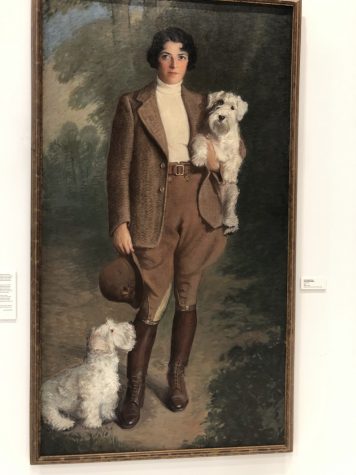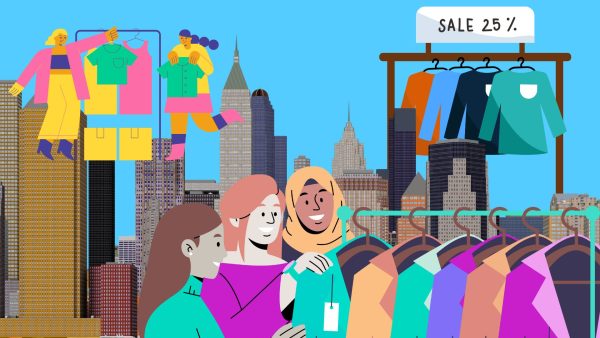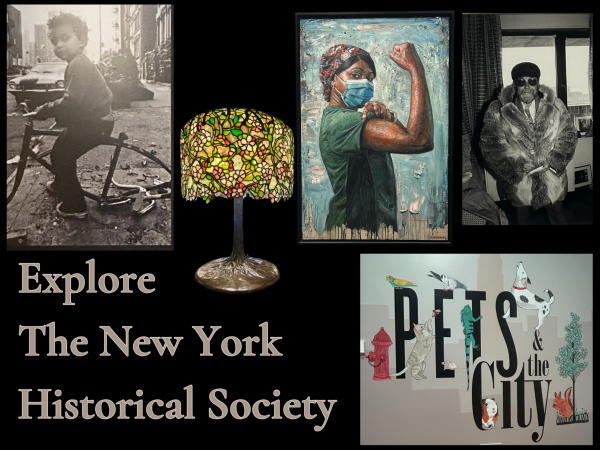Dog Culture in New York City
A Glimpse into the Lives of Dogs
Man’s best friend is brought into an art form at The American Kennel Club’s Museum of the Dog, where faux barking echoes off of the elevated ceilings and where not a single real dog is in sight. Shadows of dogs are projected around the walls, drawing focus to the wide collection of tiny dog statues.
The bright and crisp three levels of the museum hold the depth of our loved and cherished pets. From a dog’s footstep that was uncovered dating back to the Roman Empire to an interactive “How to Train a Dog” technology, the museum covers the history of dog breeds in America and how dog culture has changed over time.
In front of the museum, there is an interactive area where a touch screen and camera determines what kind of dog you most associate with. The quirky feature allows people to connect with their dog-loving selves and continue to enjoy the vast array of paintings. There are also touch screen tables throughout the museum allowing visitors to get to know any of the 193 registered AKC dog breeds. This interactive feature gives quick details about the dog’s personality traits, the history, and the households each dog would work best in.
Honoring the dog training and show world, the museum has many paintings highlighting the long tradition of dog shows, dating back to the late 1800s. Taking up an entire wall, there was a painting by John Dwight Bridge featuring Beatrice Godsol and two Sealyham Terriers. Godsol was a well known female figure in the dog show world in the 1900s. Although she adored her Sealyham Terriers, on her downtime she bred Newfoundlands and became the president of the Newfoundland Club of America. She lived by the saying “All dogs have faults. The great ones carry them well.”
After looking at all of the famous presidential and royal dogs, as well as the winners of dog shows, none of the dogs featured in the museum have been Instagram famous. It is a rising trend amongst dog lovers to create Instagrams honoring and parading their pets; it is the niche corner for pets. It is typical for these accounts to gain hundreds of thousands of followers and sponsorships with companies for toys, treats, costumes, and much more.
 A popular dog Instagram account, @pavlovthecorgi has over 122,000 followers as well as being sponsored by Stella and Chewy’s dog food and treats. Pavlov also has merch available to the dedicated followers and admirers of the account to buy. This animated pooch has more followers than the majority of average people who use social media. Anthony, one of the owners of Pavlov, otherwise known as @pav.dad on Instagram, “feels like people, especially those with dog Instagram accounts, are more interested in interacting with Pav when they find out that he’s “famous.’” However, Anthony states “he’s still “just a regular dog” and the only way we treat him differently now is being able to provide him with more of the things he loves.”
A popular dog Instagram account, @pavlovthecorgi has over 122,000 followers as well as being sponsored by Stella and Chewy’s dog food and treats. Pavlov also has merch available to the dedicated followers and admirers of the account to buy. This animated pooch has more followers than the majority of average people who use social media. Anthony, one of the owners of Pavlov, otherwise known as @pav.dad on Instagram, “feels like people, especially those with dog Instagram accounts, are more interested in interacting with Pav when they find out that he’s “famous.’” However, Anthony states “he’s still “just a regular dog” and the only way we treat him differently now is being able to provide him with more of the things he loves.”
Dogs have always contributed to working-class society, but the ways in which they contribute have changed. In one of the hallways in the Museum of the Dog, they featured movie posters from highly acclaimed dog movies, such as Old Yeller and Lassie. These movies depict the pets as spirit animals to “Challenge a wilderness and conquer a dream,” as put on the Old Yeller movie poster. People mainly owned dogs to protect the family, to go hunting with, and to have as a partner to complete duties around the house. In the 21st century, people primarily parent dogs, rather than own dogs.
“I think the presentation of dogs is changing because of social media but at the end of the day the relationship between dogs and humans lives off the internet,” Anthony highlights as a shift in the way people view “man’s best friend.” As a result of social media, “lots of people, especially millennials are waiting longer to have kids and spending more time with their pets in a pseudo-child relationship,” Pavlov’s owner states. It is less about having a dog to protect the family and to work around the farm, and more about having a companion or “child” to spoil and find comfort in. In the book “The Secret Language of Dogs,” by Victoria Stilwell, she talks about how the thousands of years of domestication have shaped the personalities of dogs; or rather how dogs have adapted to human needs. “They(dogs) can also understand easy words and imitate human physical language, and they may also be able to empathize with our emotions,” Stilwell explains, which is a big reason why people become so attached to their dogs and treat them as their own.
Another ambitious pet owner, Elizabeth Prather decided to create an Instagram for her Goldendoodle five years ago when dog Instagram accounts were not as popular, so she hid it from others until it gained attention. Now, @genevieve_the_cute_dog has more than 23,000 followers! “I find Genevieve’s social life very laughable at times, and I often joke that she is more popular than me,” Prather reflects, pinpointing that dogs are starting to have functioning social lives, friends, and jobs, just like humans. Similar to Pavlov, Genevieve (the Goldendoodle) “actually got signed in an agency which sends her campaigns to participate in,” which has led Prather and Genevieve to work with Petco, Kay Jewelers, as well as promote a campaign for the Superbowl. Genevieve promotes brands just as human social influencers do.
“Investing in a dog’s social life has always been something prevalent within society, but recently, social media has taken this out of proportion at times,” Prather explains. The fact is that social media is oversaturated with dog accounts, which has influenced this new owner mentality when “humans love their dogs and they are essentially [their] children.” Another point Stilwell makes in her book(“The Secret Language of Dogs”) is that “Oxycontin is the hormone responsible for social bonding,” and it “plays a large part in the social and emotional bonding between dogs and humans.” This may be a contributor to how relationships between humans and dogs have intensified as the codependency has increased.
Although these owners are able to bring in a solid amount of cash flow based on the online personalities of their pets, it does not change their overall relationships. Both Anthony and Prather agree that the emotional experiences of their pets are important, but not above their own. The new trends of birthday parties, costumes, dog-themed restaurants, and dog Instagrams are only a plus for these owners when building a relationship with their pets. “My relationship with Genevieve is what I could describe as one of the purest relationships I have,” Prather admits, explaining that after a bad day the “thought of coming home to a tail-wagging dog is one of the best feelings.”
Thus, the horizon for the lives of dogs has only increased over time, allowing owners to create a more emotionally connected bond with their pets. After all, the difference between selfies of dogs on Instagram versus century-old paintings of dogs properly posed in a museum is not huge! Even though the social lives of dogs are becoming more human-like, one thing that remains the same is that dogs are some of the best companions and make life a lot more fuzzy and fun!






